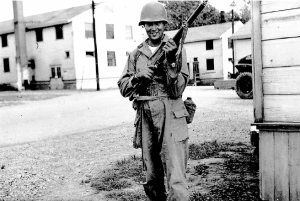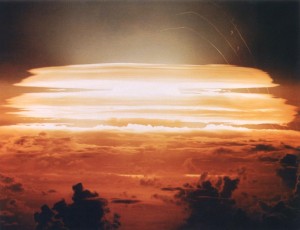By Patrick Meier
My grandfather, Stephen Patrick Meier, participated in the creation of the deadliest weapon of its time. One could say that the Cold War was fought not with guns, but with science and political maneuvering. H.W. Brands focuses on the political debate surrounding the hydrogen bomb, but my grandfather’s story is about the science and actual creation of the hydrogen bomb. In the end, however, Stephen Meier’s opinions on the matter reinforce Brands’s interpretation about the development of thermonuclear weapons. Some have called it a dangerous escalation in the Cold War. Others, my grandfather included, think of it as a necessary evil, one that “kept us safe” despite its danger.
Stephen Patrick Meier graduated Earlham college in 1952 with a bachelor’s degree in physics. After a year in Indiana working for RCA, he was drafted into the Army.
Basic training occurred that year at Fort Knox, after which Meier was assigned to Aberdeen, Maryland. From there he was transferred to Edwards Air Force Base, and transferred yet again a few months later to Kirkland Air Force Base. In the span of only a few months Meier went from basic training in Kentucky, to the Aberdeen Proving Ground in Maryland, to the Aberdeen Bombing Mission outside of Los Angeles, and finally to Kirkland AFB in Albuquerque, New Mexico as part of the Aberdeen Bombing Mission Special Weapons Liaison Group.
Being a physics major, Meier’s main role was creating bombing tables for the new hydrogen bombs. In layman’s terms, he conducted tests to determine how the fallout from bombs would disperse in the air. In his own words, “depending on the way the bomb acted when it was released we would put numbers into the bombing system to make the sure the bombs went toward the target. Of course if you’ve got 8 and half megatons it doesn’t make a whole lot of difference!” [1]
Meier’s involvement with the hydrogen bomb began in 1953, an entire year after the United States’ first detonation of a fusion device, and months after the Soviet Union’s creation of a weaponized hydrogen bomb [2]. At the time of his involvement, the Soviet Union had already successfully created a hydrogen bomb that could be dropped from a plane. The Cherokee test (which Meier had worked on), according to nuclearweaponarchive.org, “was the first U.S. air drop of a thermonuclear weapon. This… was intended to gather weapon effects data for high yield air bursts, but also was a political demonstration of the United States capability to deliver H-bombs by air to pressure the Soviet Union.” [3].
His work then ended in 1955, so while important and interesting work, his story itself says little about the political concerns that factored into President Truman’s decision to go ahead with development of thermonuclear weaponry. When asked about what he thought of his project at the time, Meier said, “Politics didn’t enter into it as far as we were concerned. It might have somewhere else but not for us.” [4]
That somewhere else was Washington, where debate over whether or not to even create fusion weapons had raged for years previously. The General Advisory Committee to the Atomic Energy Commission was a panel made up of scientists tasked with helping to decide what course of action the United States should take in terms of nuclear weapons. The panel published the Acheson-Lilienthal Report on October 30, 1949. Their report was split into two sections, signed by two different groups within the committee, as each side could not agree unanimously on certain issues. One thing, however, was clear. “Although the members of the Advisory Committee are not unanimous in their proposals as to what should be done with regard to the super bomb,” explains the report, “there are certain elements of unanimity among us. We all hope that by one means or another, the development of these weapons can be avoided.” [5]
In this report, they condemned the creation of the hydrogen bomb, on the basis that current weapons were sufficient for destroying military targets. The hydrogen bomb, on the other hand, seemed too dangerous for civilians. They wrote:
“It is clear that the use of this weapon would bring about the destruction of innumerable human lives; it is not a weapon which can be used exclusively for the destruction of material installations of military or semi-military purposes. Its use therefore carries much further than the atomic bomb itself the policy of exterminating civilian populations.” [6]
The project was meant to be a secret. Meier says, “security wise I was top secret and q-clearance, which was atomic energy clearance. Actually I think the q-clearance was higher than top secret. And really it was pretty well contained right on the base. We didn’t talk about it.” [7] Brands says little on the actual development of the hydrogen bomb, choosing instead to focus on the debate surrounding its creation and the impact its construction had on the relations between the United States and the Soviet Union. Brands states that although the debate over the hydrogen bomb was meant to be secret, it didn’t stay that way for long. Details were soon leaked to the press and public opinion was not one-sided. One expert, Ralph Lapp, even claimed that “for America to build the bomb would be like ‘the man who lives in a tar paper shack and develops a flame thrower to defend himself’.” [8]
Meier’s stance, then and now, is that creating the hydrogen bomb was the right thing to do at the time. However, he is not without his qualms. He says, “it was such a dramatic increase in destructive capability. And you know you had to be thinking long and hard, I don’t care what kind of madman you were, to even unleash such a thing. It was terrible.” [9]
We can see hints of this uneasiness in this letter written by Chief Herman Miller, Meier’s supervisor at the Aberdeen Bombing Mission Special Weapons Branch. This letter was sent to RCA notifying them of the end of Meier’s military service and return to work at RCA. He says in the letter that “Cpl Meier has proven himself to be an outstanding individual who has placed duty far above his own personal feelings and comforts.” [10] In hindsight however, during my interview with him, Meier decided that “I think we should have [created the hydrogen bomb] to be honest about it. It kept us safe.” [11]
He was not the only one with that opinion. Lewis Strauss believed that “the United States must be as completely armed as any possible enemy.” [12] Essentially, the United States was obligated to create fusion weapons just in case the Soviets were creating them too. This eventually motivated President Truman to go ahead with development of the hydrogen bomb. Additionally, the fear of the Soviets being able to make a hydrogen bomb turned out to be justified. The Trinity Test at Alamogordo in July 1945 predated the Soviet’s first atomic bomb by almost four years. [13] America’s first hydrogen bomb, however, beat the Soviet’s first hydrogen bomb by only one year. The gap was closing. However, The United States had one more card to play yet in the race for thermonuclear superiority: Turkey.
The eventual incorporation of Turkey into NATO lent the United States a distinct advantage at this stage of the war. Turkey’s airfields and America’s new, powerful, deliverable thermonuclear bombs kept pressure on Soviet borders. [14] The Cold War, however, was only beginning.
[1] Stephen Meier, phone interview, March 21, 2015.
[2] H.W. Brands, American Dreams: The United States since 1945 (New York: Penguin Books, 2010), 66.
[3] “Operation Redwing.” Operation Redwing. Accessed March 25, 2015. http://nuclearweaponarchive.org/Usa/Tests/Redwing.html.
[4] Phone interview with Stephen Meier.
[5] PBS, American Experience, Race for the Superbomb. Accessed April 28, 2015.
http://www.pbs.org/wgbh/amex/bomb/filmmore/reference/primary/extractsofgeneral.html
[6] Ibid
[7] Phone interview with Stephen Meier.
[8] Brands, 66
[9] Phone interview with Stephen Meier.
[10] Herman Miller to W.F. Warrender, June 2, 1955.
[11] Phone interview with Stephen Meier.
[12] Brands, 66.
[13] Ibid, 66.
[14] Ibid, 67.


